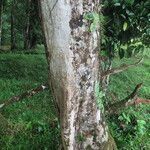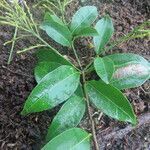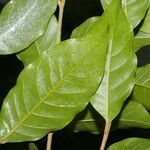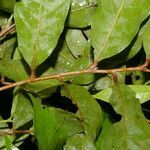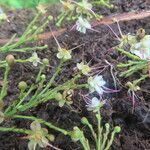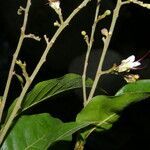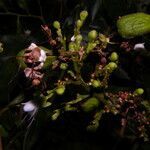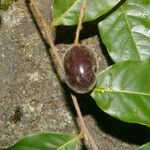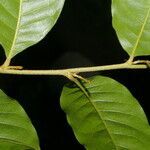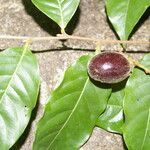Large shrub or a tree, often 5-6 m. high (sometimes to 20 m. with a trunk 15-20 cm. in diameter), with slender pubescent branchlets 1-2 mm. in diameter below the inflorescences; inflorescences and juvenile foliage and branchlets more or less appressed-pubescent with two types of hairs intermingled: straight, slender, pointed, yellow or tawny, usually appressed hairs 0.5-1 mm. long, and straight or crisped often erect white hairs 0.3 mm. long or less; the longer, yellow hairs pre-dominating on the leaves, while in the inflorescence the two types are often equally intermingled except on the inner surfaces of the calyx-lobes, where the shorter, White hairs alone occur. Leaves elliptic or sometimes oblong, glabrate or the principal veins persistently hairy, the hairs of the leaves often with enlarged papillose bases; blades rather thin, 2-5 cm. wide, 6-12 (-15) cm. long, 2-3 times as long as wide, rather abruptly acute at apex and with a definite narrow sharp-pointed acumen 0.6-2 cm. long; base of blades acutely narrowed from below the middle, the extreme base not decurrent but often abruptly rounded and so truncate or even subcordate, and sharply delimited from the stout petiole 1-2 mm. thick and 2-4 mm. long; lateral veins 5-8 pairs, arcuate, not very prominent, slightly elevated on the lower surface; glands occurring on the lower surface of the blade (occasionally on the upper surface), mostly near base, often very small, 0.2 mm. across, but sometimes reaching 0.5 mm., elliptic or circular, with raised rim and depressed center; stipules subpersistent, hirsute, subulate, appressed, 3-5 mm. long. Flowers in axillary and terminal raceme-like panicles 3-7 cm. long, the "racemes" compound but the lateral cymes most often reduced each to 1 or 2 flowers and the inflorescence giving the appearance of a simple raceme with bracteolate pedicels 8-15 mm. long (actual pedicels 2-3 mm. long); bracts of the cymes lanceolate, attenuate, minutely glandular-denticulate, 1.5-3 mm.; petals white, broadly ellip-tic, rounded at both ends, about 5 mm. long and 3-3.5 mm. wide, glabrous; stamens 3, opposite adjoining sepals, much exserted, pink or purple, glabrous, the filaments 1.2-1.6 cm. long, fleshy and about 1 mm. wide at base and tapering to the very slender tips, arising separately from the hypanthium-rim which is fleshy and projects about 0.5 mm. above the base of the calyx; anthers about 0.6 mm. long; hypanthium campanulate, the cavity funnelform, about 1.8-2 mm. deep, retrorsely hairy within the fleshy rim but glabrous at bottom; calyx-lobes oblong to suborbicular, rounded at tips, reflexed after anthesis, entire, 2-2.5 mm. wide, 3-3.5 mm. long, the outer surface with long yellow appressed hairs and scattered small white hairs also, the inner surface white-tomentulose; ovary hirsute, sessile; style as in H. americana, but up to 1.5 cm. long. Fruit dark red or purple, oblong-obovoid, up to 2.3 cm. long and 15 mm. thick, with rounded apex and thick, short, stipe-like base, rather densely yellow-hairy.
More
A medium sized tree. It grows up to 5-12 m tall. The leaves are simple and alternate. They are small and short. The leaves are shiny green above. The new leaves have round black spots. They have stipules in pairs at the base. The flowers are white with long pink stamens. They are in clusters. The fruit is fleshy and has one pointed seed. This has fine grooves.
